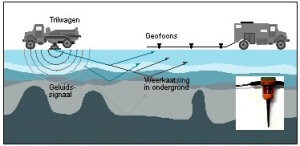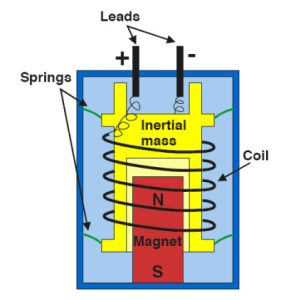Magnets are used in a wide variety of applications. For measuring movement, for example, in vibration sensors and angle sensors. This article focuses on a specific type of vibration sensor, commonly referred to as a geophone. A number of other interesting possibilities are also mentioned at the end of this blog.
A geophone is a type of microphone which detects vibration in the ground. A mobile vibration rig sends a sound wave into the ground, either by triggering an explosion or by striking the ground with great force: see the figure below.
The sound wave spreads through the subsurface in all directions. When it encounters a change in structure in the subsurface, the sound wave is reflected back in the form of multiple weaker waves, which are deflected in different directions. These reflected sound waves are detected with geophones (behind the instrumentation truck on the left). The sound signatures captured in this way are stored in a computer and plotted using a special programme. The result is a cross-section of the subsurface structure where these changes can be seen. A 3D subsurface model can be created by combining multiple subsurface cross-section plots.
A geophone is basically a permanent magnet and a coil. The coil is wound around a heavy core that is suspended on springs. When the ground vibrates, the entire unit moves. However, the core hardly moves at all due to its high mass and the flexible mounting arrangement. As a result, the coil moves relative to the magnet and generates a small electric current. To produce an accurate reading, the magnet must generate a magnetic field within the right tolerances.
D&D Production & Sourcing has supplied magnets for geophones for many years. The material used for the magnets is AlNiCo; a combination of aluminium, nickel and cobalt. The strength of the magnet must lie within a narrow tolerance band in order to guarantee accurate measurement.
In addition to magnets for geophones, D&D Production & Sourcing can also supply magnets for other applications, e.g. angle sensors. The following materials are available: ferrite (MeFe2O4), an alloy of samarium and cobalt (SmCo), or an alloy of neodymium, iron and boron (Nd2Fe14B).
For more information, click here.


